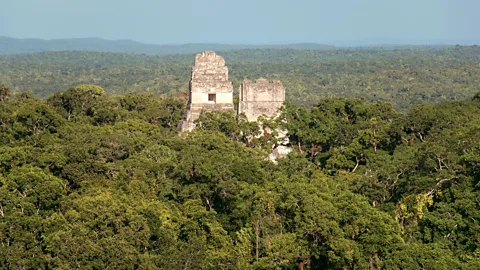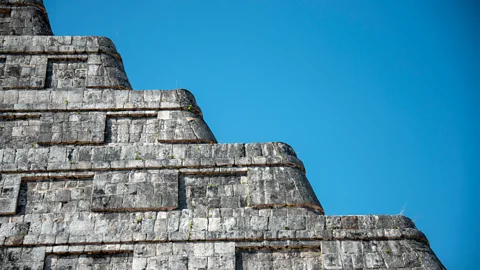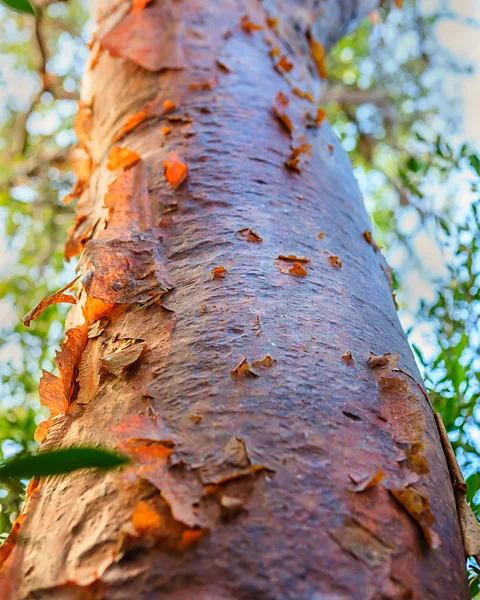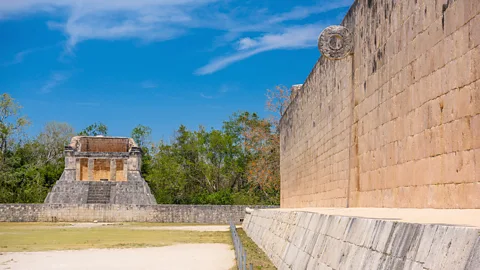Rubber and tree sap: How ancient Maya cities have withstood the ravages of time
 Getty Images
Getty ImagesRuins of ancient cities keep turning up in the forests of central America. How have these structures remained standing for millennia despite tropical rains, hurricanes and the return of the jungle?
Anyone driving down the rough asphalt of highway 269 that bisects the Yucatán peninsula in southeast Mexico would never have known it was there. Thick jungle lines both sides of the road for much of its length, with the occasional patch cleared for livestock. Yet, after an innocuous bend in the road, close to the tiny settlement of Dos Lagunas, an entire city has been hiding.
Concealed beneath a tangle of trees, vines and other vegetation, scientists have discovered a sprawling collection of houses, plazas, temple pyramids and even a ballcourt used for ball games that have the "hallmarks of a Classic Maya political capital". The remains of the city, which the researchers have named Valeriana, are among 6,674 structures they found scattered in sites across the state of Campeche on the western side of the Yucatán peninsula. Some of the largest platforms may even rival more famous pyramids at other Maya sites.
The discovery – made using an airborne laser scanning technique called light detection and ranging, or Lidar – has raised the tantalising prospect that many more remains of the ancient Maya world may still be waiting to be found.
But it also reveals something extraordinary about the ancient Maya world. Despite the humid tropical climate and the enveloping embrace of the jungle, many of their buildings are still standing after 1,500 years.
"If you look at the digital terrain models that are produced by Lidar, you can see the individual rooms of buildings where the vaults have collapsed," says Luke Auld-Thomas, an archaeologist at Tulane University and Northern Arizona University, USA, who led the team that made the latest discovery. "You can see columns along the facade of buildings that were used for public facing, administrative activities. So they're actually in very good shape. You couldn't quite move into them, but a lot of them still have standing walls and architectural detail that's quite well preserved."
So, what was the ancient Maya's secret? How has their famous architecture withstood the ravages of time? Recent research is shedding light on the techniques their builders used and revealing the innovative approach their masons used. These include incorporating materials such as rubber into mortars to act as an adhesive, and volcanic ash to increase their strength.
 Getty Images
Getty ImagesThe ancient Maya civilisation first emerged sometime before 2000BC in an area that today comprises south-eastern Mexico, Guatemala, Belize and the western portions of Honduras and El Salvador.
During the Classic Period of Maya civilisation between 250 to 900 AD, the Maya constructed towering pyramid temples, beautiful palaces and finely decorated buildings adorned with intricate sculptures and ornately carved masks. Notable examples include Chichén Itzá, a site in Yucatán, Mexico, which boasts at its heart a 30m-high (98ft) pyramid called the Temple of Kukulcán. There is also Temple IV, a 65m-tall (213ft) pyramid in the ruins of the ancient Maya city of Tikal in modern Guatemala.
In the past, uncovering a Maya city involved wading through thick jungle and hacking through vegetation with a machete. But technology such as Lidar is now helping to reveal just how widespread the remains of ancient Maya settlements really are.
Juan Carlos Fernandez-Diaz, an engineer at the University of Houston, Texas, who was involved in the latest study, has been mapping areas in Mesoamerica – including Mexico, Guatemala, El Salvador and Honduras – with Lidar for the last 15 years. He says that almost wherever you look you can see well preserved Maya architecture.
Recent discoveries include the oldest and largest Maya ceremonial structure, which was uncovered at the archaeological site of Aguada Fénix in Tabasco, Mexico in 2020. The long, rectangular elevated platform measures 1,400m (4,593ft) in length and 10-15m (33-49ft) in height. It was built from clay and earth between 1,000 to 800 BCE and was likely used for ceremonial rituals.
A separate team used Lidar to uncover a massive Maya site that stretches approximately 650sq miles (1,700sq km) across northern Guatemala. The scientists spotted 1,000 settlements connected to each by roads that the Maya likely traversed on foot.
"As we get to map more and more of the Yucatán, we basically know that if you throw a dart at the map, wherever that dart falls there will be some sort of Maya infrastructure on it," says Fernandez-Diaz.
Part of the reason these discoveries are standing at all is because the ancient Maya built with stone, which does not rot away like wood. But they were also particularly good at making mortar to prevent their stone structures from crumbling into piles of rubble.
Studies have shown that ancient Maya builders used a range of natural materials such as blood, eggs and natural rubber obtained from local trees when preparing mortar. For example, when in 2018 researchers analysed mortar taken from stones at the main pyramid at the Witzinah archaeological site near Yucatán, Mexico, they found traces of saturated fats typical of degraded natural rubber. The researchers believe the Maya masons obtained the rubber from local trees and used it as a binder along with a fine-grained clay to create a durable mortar to bind the stonework together.
A separate study in 2014 examined mortar samples from the archaeological site of Río Bec in south-eastern Campeche, finding evidence that Maya stone masons added volcanic ash to the mortar to strengthen it.
Perhaps even more surprising than their stone structures, however, is the preservation of decorated plasters that have also been discovered in some locations. Scientists have known for some time that the ancient Maya knew how to make lime plaster, which they used to coat and protect interior floors or wall surfaces, bind stones together and cover and decorate the surface of stone buildings. Examples of intricately decorated plaster-covered buildings can still be seen in Tikal and Copan, an ancient Maya site in Honduras, today.
In 2023, Carlos Rodriguez-Navarro, a mineralogist at the University of Granada in Spain set out to discover how the ornate lime-plaster covered sculptures and temples at Copan remained in excellent shape despite being exposed to a hot, humid tropical environment for more than 1,000 years.
As part of his study, Rodriguez-Navarro's team met with local stone masons in the area and asked them about their techniques for making lime mortar. The masons, who are direct descendants of the ancient Maya, said that they commonly use extracts from plants and particularly sap from the Chucúm and Jiote (Chaká) trees in their lime mix.
Next, the researchers analysed the ancient plaster from the Honduras site and prepared a replica of it. The process of making plaster involves baking (calcinating) carbonate rock material such as limestone using hot temperatures, before adding water to the resulting quicklime, forming a lime paste which is mixed with sand. As the material hardens it sucks carbon dioxide from the air, trapping it in the calcite cement. The researchers also took the advice of the stone masons and added juice from the bark of Chucúm and Jiote trees to the mix. They found that the resulting plaster was especially hardy and durable.
"We were able to exactly replicate the structure, texture and mechanical properties of the ancient material," says Rodriguez-Navarro.
 Getty Images
Getty ImagesThe scientists then analysed the original plaster using high resolution X-ray diffraction, a technique that enabled them to view the material at the atomic scale. The results showed that molecules of the organic material from the bark had become incorporated into the molecular structure of the lime plaster during the setting, or hardening process. According to Rodriguez-Navarro, this makes the material very durable and resistant to physical and chemical weathering.
"It's very hard to break the material, because it is a composite between organic and inorganic materials," says Rodriguez-Navarro. "So, if you try to break the purely inorganic calcite it is very simple – it's fragile, so you just hit it, and it collapses. But if you incorporate the organic atoms from the tree sap you make the material tougher. So, the energy you have to spend to break that material is really, really high."
The incorporation of organic plant material also makes the material more insoluble, which prevents it from dissolving in the rain – an important feature in the tropical climate that is often buffeted by hurricanes bringing heavy rain.
Other studies at sites such as Ek'Balam in Yucatán, Mexio, also found that extracts from another tree – pixoy, or Guazuma ulmfiolia – helped to act as a fixative to preserve the layers of colour used in the lime-plaster.
There is, of course, another reason why the ruins from abandoned Maya cities may have lasted as long as they have – the jungle itself. Although the trees have made the ruins hard to find, they have also protected them from being built over and looted.
"There are parts of the world where people have bulldozed pyramids to use as road fill, or because they're in the way of where they want to run cattle," says Ault-Thomas. "However, it's hard to do that when there are a gazillion trees in the way."
 Getty Images
Getty ImagesThe Maya also transformed the landscape around their settlements to help protect them from the ravages of water. Auld Thomas saw evidence of this at the site of Valeriana he helped to discover.
"It's also in an area that's extensively modified for agriculture," he says. "It's quite hilly, and basically every sloping surface that is above the level of seasonal flooding is sculpted, terraced and completely reworked so that people could use it to grow food and keep their feet dry in the rainy season."
So, could modern societies learn anything from these ancient Maya builders when it comes to creating cities that are resilient to climate change?
"The Maya case really shows that it's possible to manage the landscape in a way that allows it to survive and thrive for a millennium, even in fairly extreme environments where it doesn't rain for half the year, but then rains every day for the other half of the year," says Auld-Thomas.
We could learn from the Maya's choice of materials too. The reinforced concrete found in most modern buildings is strong enough to hold up massive skyscrapers, but they aren't built to last. The lifespan of most steel reinforced concrete buildings is around 50 to 100 years. At the same time, cement production currently accounts for 8% of global carbon emissions – far more than aviation.
Some researchers are looking to lime-based alternatives to cement. Currently, lime production is a major source of carbon dioxide emissions, but some researchers are investigating obtaining it from other sources, such as the by-products of the paper industry, for example, which may make it more sustainable. Drawing on the knowledge of the ancient Maya as inspiration could help to make such materials more durable, says Rodriguez-Navarro.
Lime mortars can also act as a carbon sink, absorbing carbon dioxide from the air as they remineralise and harden into limestone.
"Lime is attracting a lot of attention as a possible sustainable material for modern construction," says Rodriguez-Navarro. "Not only will it suck up CO2 during carbonation, but at the same time you get a very durable material if you add the proper organic additives."
--
If you liked this story, sign up for The Essential List newsletter – a handpicked selection of features, videos and can't-miss news, delivered to your inbox twice a week.
